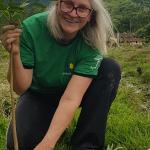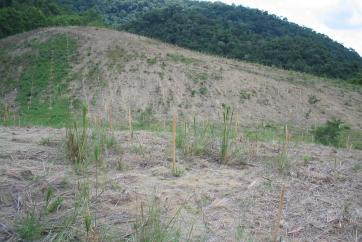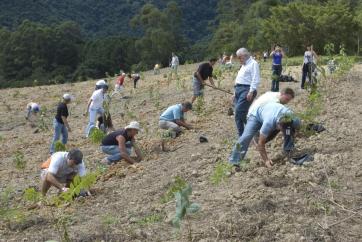The Mata Atlântica is considered a National Heritage by the Federal Constitution and fully or partially covers 17 Brazilian states and more than 3,400 municipalities. Originally, it covered 15% of the Brazilian territory, an area equivalent to 1,310,299 Km2. After the country's colonization and industrialization process, 12.4% of the original remnants remain. If we consider well-preserved fragments, above 100 hectares, the number decreases, remaining at only 8.5%. The restoration of the Mata Atlântica should be a priority and be inserted in the global agenda for combating the climate crisis.
Given the climate emergency scenario, the conservation and restoration of landscapes and ecosystems has become a priority at the international level. Many studies show that avoiding deforestation of remaining forests, conserving biodiversity and planting trees are one of the best ways to help combat and mitigate the effects of climate change.
Considering the benefits for biodiversity conservation and climate change mitigation, the Mata Atlântica should be one of the Biomes with the highest priority for restoration in the world. According to a study published in the journal Nature, the biome is part of a group of ecosystems in which the restoration of 15% of its area would prevent 60% of the predicted extinction of species and, at the same time, would sequester the equivalent of 30% of the CO2 released into the atmosphere since the beginning of the industrial revolution.
We are in the Restoration Decade and in this context Apremavi presents itself with an experience of over 30 years in conservation and restoration. We have already helped create and implement several Conservation Units and carry out restoration projects. All seedlings donated and planted by the project are produced by Apremavi in the Jardim das Florestas nursery.
To draw society's attention to the Mata Atlântica and the need to preserve existing remnants and also restore whatever is needed, Apremavi launched the mobilization campaign “Conservation and Restoration go hand on hand”. Come with us. Every tree is important. Every seedling counts. Every activity makes a difference. We also highlight the importance of women's work in restoration. Disseminating the stories of women who are protagonists in the restoration and planning of properties and landscapes is a way of making society aware of the importance of women's actions in mitigating the climate crisis and promoting the planting of native trees and the recovery of degraded areas. We want to increasingly inspire the participation of women in this agenda, and because of that we tell stories like the one from teacher Ercília Leite.
Ercilia and the dream of having a forest
It was 1996 when Ercília Felix Leite returned to her parents' house, Silveira Felix Leite and Zulmira Guethen Leite, in the city of Taió, state of Santa Catarina, south of Brazil, to take care of them. She left work at the secretariat of the Parish of Nossa Senhora das Mercês, in Curitiba (Paraná state) and went to work as an elementary school teacher. Receiving a small piece of land as an inheritance, her dream was to have a forest. This dream began to come true in 1997, when together with Ewald Heidrich, they planted the first seedlings of native trees. Ercília is one of Apremavi's partners in the restoration projects of the Mata Atlântica. In all, more than 18 thousand seedlings of 45 native species were planted. Ercília estimates that with the enrichment action that she has been doing over the years and the regeneration process itself, today there are about 30 thousand specimens of flora in the area.
She is very proud that she managed to make the dream come true and that this dream is a true miracle because it is bringing countless benefits: “the waters have returned. Springs that were dry were reborn and today we have an abundance of pure water that supplies our house, garden and orchard. In addition, there are animals that help to spread juçara palm seeds and other species. There are bees that produce honey and we have already harvested many pine nuts from the araucarias that were planted. Not to mention nature baths, which are essential for health. I live immersed in nature”, says Ercília, who today shares the care of the forest with her companion Roberto Odebrecht.
Of the 20 hectares of the “Pequeno Paraíso” property where Ercília and Roberto live, 5 are rice fields, the rest are restoration areas, gardens and orchards. She says that in the community many have already been inspired by the example: “our community has changed a lot. The neighborhood cultivates gardens, plants trees and orchards. As it was, with destruction, it had no future. Here is our paradise”.
Ercília is a woman who restores.
About the author

Miriam Prochnow is a specialist in pedagogy and ecology. She works in the environmental field, focusing on monitoring and proposition of public policies, sustainability, environmental education and institutional development. She has over 30 years of experience in coordinating civil society organizations, executing conservation projects and sustainable use of natural and cultural resources, campaigns, institutional development and production of materials and publications, having worked with NGOs, networks and the Federal Government. She is the founder of the Association for the Preservation of the Environment and Life (Apremavi) and was the Coordinator of the Federation of Ecological Entities of Santa Catarina (FEEC) and of the Atlantic Forest NGO Network (RMA). She has also worked on the development and implementation of environmental programs and their negotiation with different sectors, such as the Climate Observatory, the Forest Code Observatory and the Brazilian Coalition on Climate, Forests and Agriculture. She is an Avina leader, amateur photographer and presenter of Apremavi videos.







